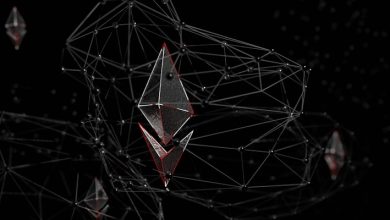EOS: High-Performance Blockchain for Decentralized Apps

- Understanding EOS and its role in the world of blockchain technology
- Exploring the benefits of using EOS for decentralized applications
- How EOS is revolutionizing the way decentralized apps are built and operated
- The key features that make EOS a high-performance blockchain platform
- A closer look at the scalability and speed of EOS for handling large-scale applications
- The future potential of EOS in the rapidly expanding world of decentralized apps
Understanding EOS and its role in the world of blockchain technology
EOS is a high-performance blockchain platform that has gained significant traction in the world of blockchain technology. It is known for its ability to support decentralized applications (dApps) with high scalability and low latency. EOS aims to address some of the limitations of other blockchain platforms, such as slow transaction speeds and high fees.
One of the key features of EOS is its consensus mechanism, known as Delegated Proof of Stake (DPoS). This mechanism allows for fast block confirmation times, making it ideal for applications that require real-time interaction. Additionally, EOS has a unique governance model that enables stakeholders to vote on decisions related to the platform’s development.
EOS has been used for a wide range of applications, including social media platforms, gaming, and decentralized exchanges. Its high throughput and low fees make it an attractive option for developers looking to build scalable dApps. As the blockchain ecosystem continues to evolve, EOS is poised to play a significant role in shaping the future of decentralized technology.
Exploring the benefits of using EOS for decentralized applications
EOS offers a wide range of benefits for decentralized applications (dApps) that set it apart from other blockchain platforms. One of the key advantages of using EOS is its high performance, which is achieved through its delegated proof-of-stake (DPoS) consensus mechanism. This allows for fast transaction speeds and scalability, making it ideal for applications that require real-time processing and high throughput.
Additionally, EOS provides a user-friendly development environment with its support for a variety of programming languages, including C++ and Rust. This makes it easier for developers to create dApps on the platform without having to learn a new language. Furthermore, EOS offers free transactions for end-users, removing the barrier to entry for users who may be deterred by transaction fees on other blockchain networks.
Another benefit of using EOS for dApps is its governance model, which is designed to promote transparency and accountability within the ecosystem. This helps to ensure that the platform remains secure and stable, providing users with confidence in the reliability of the applications built on EOS. Additionally, EOS features a robust system for dispute resolution, allowing for conflicts to be resolved in a fair and timely manner.
How EOS is revolutionizing the way decentralized apps are built and operated
EOS is transforming the landscape of decentralized applications by providing a high-performance blockchain platform that offers scalability, flexibility, and ease of use. Unlike traditional blockchains, EOS utilizes a delegated proof-of-stake consensus mechanism that enables faster transaction speeds and lower fees. This innovation has made it a popular choice for developers looking to build decentralized apps that require high throughput and low latency.
One of the key features of EOS is its ability to support a wide range of decentralized applications, from social networks to gaming platforms. This versatility has attracted a diverse community of developers who are leveraging the platform’s capabilities to create innovative and interactive dApps. By providing developers with access to a robust set of tools and resources, EOS is empowering them to bring their ideas to life in ways that were not possible before.
Moreover, EOS is revolutionizing the way decentralized apps are operated by introducing features such as built-in governance mechanisms and self-sustaining economic models. These features help ensure that dApps running on the EOS platform remain secure, transparent, and efficient. Additionally, EOS’s support for smart contracts allows developers to create complex, self-executing agreements that automate processes and reduce the need for intermediaries.
Overall, EOS is setting a new standard for decentralized app development by offering a high-performance blockchain solution that is both user-friendly and developer-friendly. With its innovative features and growing ecosystem, EOS is poised to continue driving the evolution of the decentralized app industry and revolutionizing the way we interact with digital applications.
The key features that make EOS a high-performance blockchain platform
EOS is a blockchain platform that stands out for its high level of performance and scalability, making it a preferred choice for decentralized applications (dApps). There are several key features that contribute to EOS’s reputation as a high-performance blockchain platform:
- Delegated Proof of Stake (DPoS): EOS utilizes a DPoS consensus mechanism, which allows for faster transaction speeds and higher throughput compared to traditional Proof of Work (PoW) or Proof of Stake (PoS) systems. This enables EOS to process thousands of transactions per second, making it ideal for dApps with high transaction volumes.
- Parallel Processing: EOS is designed to support parallel processing of smart contracts, allowing multiple transactions to be executed simultaneously. This feature enhances the platform’s scalability and efficiency, enabling it to handle a large number of users and transactions without compromising performance.
- Resource Management: EOS introduces the concept of “bandwidth” and “CPU” resources, which users can stake to access network resources and execute transactions. This resource management system ensures that the network remains efficient and prevents congestion, even during periods of high demand.
- Low Latency: With its fast block times and efficient consensus algorithm, EOS offers low latency for transaction confirmation. This means that dApps built on the EOS platform can provide users with a smooth and responsive experience, similar to centralized applications.
- Governance Model: EOS features a decentralized governance model that allows token holders to participate in decision-making processes and vote on network upgrades. This system promotes transparency, accountability, and community involvement, ensuring the platform’s continued development and growth.
Overall, these key features make EOS a high-performance blockchain platform that is well-suited for a wide range of decentralized applications, from gaming and social media to finance and healthcare. By combining speed, scalability, and governance, EOS offers developers a powerful tool for building innovative dApps that can compete with centralized solutions in terms of performance and user experience.
A closer look at the scalability and speed of EOS for handling large-scale applications
EOS is renowned for its scalability and speed when it comes to handling large-scale applications. This high-performance blockchain platform has been designed to cater to the needs of decentralized apps that require swift transaction processing and the ability to scale seamlessly as user numbers grow.
One of the key factors that contribute to EOS’s scalability is its delegated proof-of-stake (DPoS) consensus mechanism. By allowing users to vote for block producers who are responsible for validating transactions, EOS can achieve fast transaction speeds without compromising on security. This innovative approach ensures that the network can handle a high volume of transactions without experiencing bottlenecks.
Moreover, EOS utilizes parallel processing technology, which enables the platform to execute multiple tasks simultaneously. This means that even as the number of users and transactions increases, the system can maintain optimal performance levels. The ability to process transactions in parallel significantly enhances EOS’s scalability, making it a top choice for large-scale applications.
The future potential of EOS in the rapidly expanding world of decentralized apps
EOS has shown tremendous growth and potential in the rapidly expanding world of decentralized applications. With its high-performance blockchain technology, EOS offers developers a robust platform to build and deploy dApps that can scale efficiently to meet the demands of a growing user base.
One of the key advantages of EOS is its ability to process thousands of transactions per second, making it ideal for applications that require high throughput. This scalability is essential for dApps to run smoothly and provide a seamless user experience, which is crucial for their widespread adoption.
Furthermore, EOS’s delegated proof-of-stake (DPoS) consensus mechanism ensures fast transaction speeds and low fees, which are essential for attracting developers and users to the platform. This, combined with its governance model that allows for on-chain decision-making, makes EOS a compelling choice for building decentralized applications.
As the demand for dApps continues to grow, EOS is well-positioned to capitalize on this trend and become a leading player in the decentralized application market. Its high-performance blockchain, scalability, and governance model set it apart from other platforms, making it an attractive option for developers looking to build innovative and efficient decentralized applications.



